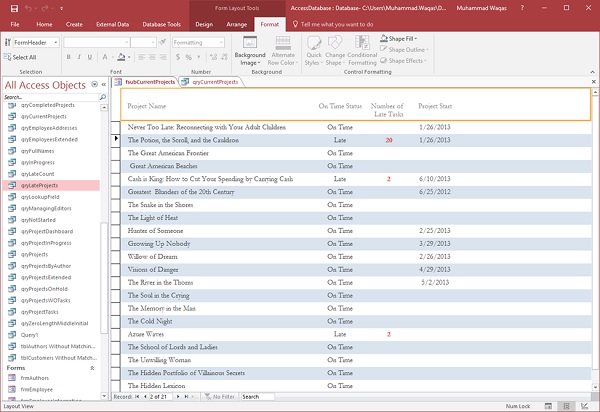Microsoft Access Conditional Formatting Examples

Keyscape Full Zip Torrent. Tip: To format a single control, click the arrow in the Show formatting rules for field • In the Conditional Formatting Rules Manager dialog box, click New Rule and select a rule type. • Select an option from Edit the rule description. • Select the formatting that you want to apply and click OK. • To add a new rule to the same field(s), click New Rule and repeat this procedure from step 4. In the following example, the top portion shows the Conditional Formatting Rules Manager set to show any item with amount due exceeding $1000 in red text. The portion below shows how the conditional formatting appears.
Microsoft Access 2000 (and later) lets you conditionally format the data in combo box and text box controls based on certain conditions through the user. Conditionally Formatting Microsoft Access Form Data: Most Microsoft Access database applications will contain user forms, both for data entry and for viewing the data.
Forms and reports The tables in this section provide examples of expressions that calculate a value in a control located on a form or report. To create a calculated control, you enter an expression in the ControlSource property of the control, instead of in a table field or query. Note You can also use expressions in a form or report when you. Text operations The expressions in the following table use the & (ampersand) and the + (plus) operators to combine text strings, built-in functions to manipulate a text string, or otherwise operate on text to create a calculated control. Expression Result ='N/A' Displays N/A. =[FirstName] & ' ' & [LastName] Displays the values that reside in table fields called FirstName and LastName.

Recently, I learned that Access' conditional formatting feature handles multiple controls. For instance, you can use conditional formatting to highlight an entire row.
In this example, the & operator is used to combine the FirstName field, a space character (enclosed in quotation marks), and the LastName field. =Left([ProductName], 1) Uses the Left function to display the first character of the value of a field or control called ProductName. Keygen For Autocad 2007. =Right([AssetCode], 2) Uses the Right function to display the last 2 characters of the value in a field or control called AssetCode. =Trim([Address]) Uses the Trim function to display the value of the Address control, removing any leading or trailing spaces.
=IIf(IsNull([Region]), [City] & ' ' & [PostalCode], [City] & ' ' & [Region] & ' ' & [PostalCode]) Uses the IIf function to display the values of the City and PostalCode controls if the value in the Region control is null; otherwise, it displays the values of the City, Region, and PostalCode controls, separated by spaces. =[City] & (' ' + [Region]) & ' ' & [PostalCode] Uses the + operator and null propagation to display the values of the City and PostalCode controls if the value in the Region field or control is null; otherwise, it displays the values of the City, Region, and PostalCode fields or controls, separated by spaces. Null propagation means that if any component of an expression is null, the entire expression is also null.